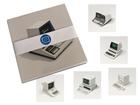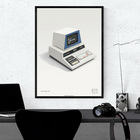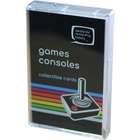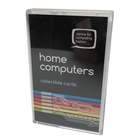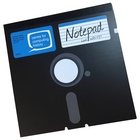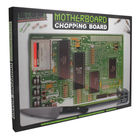Psion Series 5
| Home > Browse Our Collection > Computers > Psion > Psion Series 5 |
The Psion Series 5 is a PDA (personal digital assistants) from Psion. It comes in two main variants, the Series 5 (launched in 1997) and the Series 5mx (1999), the latter having a faster processor, clearer screen, and updated software. There is also a rare Series 5mx Pro, which differs only in having the operating system loaded into RAM and hence upgradeable. Ericsson marketed a rebadged version of the Series 5mx called the MC218.
The Psion Series 5 is a major upgrade from the Psion Series 3. A Psion Series 4 does not exist, due to Psion's concern of tetraphobia in their Asian markets. The external appearance of the Psion Series 5 and the Psion Series 5mx are broadly similar, but their mainboards and other internal components are different and not interchangeable. The screens are not interchangeable because of different screen cables.
The Series 5 was the first to feature a unique sliding-clamshell design, whereby the keyboard slides forward as the device opens to counterbalance the display, and brace it such that touchscreen actuation does not topple the device.[citation needed] This novel design approach was the work of Martin Riddiford, an industrial designer for Therefore Design. A simplified version of this design was also used in the Psion Revo.
The moving parts and hinges can wear out or break. The most serious common problem arises because of a design fault in the screen cable where tooling holes cause unnecessary stressing due to additional bending of the cable at this point each time the Psion Series 5 is opened or closed and eventually leading to failure of the cable, which causes a serious display malfunction and the appearance of vertical lines on the screen. The screen cable to the Psion Series 5 is more durable than the screen cable of the Psion Series 5mx. There is an after-market cable available for the 5mx which aims to eliminate this problem (see Psionflexi in the 'External Links' below).
At the heart is a 32-bit RISC-based ARM710T processor with MMU[1] running at 18 MHz (Series 5) or 36 MHz (5mx), with 4, 8 or 16MB of RAM. It's powered by two AA batteries, typically giving 10 – 20 hours of use. The display is a touch-sensitive, backlit half-VGA (640 x 240 pixel) LCD with 16 greyscales. The keyboard is generally considered to be among the best for its size, with large-travel keys and touch-type capability. Both RS-232 and IrDA (infra-red) serial connections are provided, along with a speaker and microphone, giving dictation ability as well as playing music. External storage is on CompactFlash.
Release Date 1997
Price £439 4mb - 499 8mb Processor 32bit risc Rom 6mb Ram 4 and 8mb models Power 2 x AA size alkaline batteries, external power 6v Backup battey Lithium (CR2032) battery Communication RS232 Fast Serial Port, IrDA Keyboard Patented touch-type laptop-style 'expanding' keyboard with a large vertical travel. 9 off-screen application quick access icons. 5 command icons to the left of the screen. Expansion 1 slot CompactFlash standard) Backlit Backlit, Size 170 x 90 x 23mm Weight 354g (12.5oz) with batteries Screen 16 grey scale 640 x 240 pixels, touch sensitive screen. Sound Microphone for digital sound recording. External buttons for record, stop/play and rewind and for silencing alarms. Internal speaker. Our Psion including the leather case was very kindly donated by Steve Furber.
Magazine Articles About Series 5
|
|



